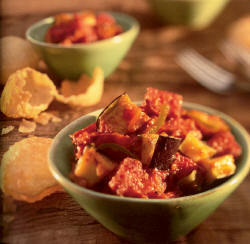 Serves 6
Serves 6
ghee for deep-frying
1½ teaspoons black mustard seeds
2 teaspoons minced fresh ginger
1 teaspoon minced fresh green chili
¼ teaspoon yellow asafetida powder
2 cups tomato puree
¼ teaspoon turmeric powder
1 teaspoon ground coriander panir cheese from 2½ litres milk, pressed and cut into 1.5 cm cubes, (recipe follows)
1 large eggplant, cut into 1.5 cm cubes
1 teaspoon garam masala
2 teaspoon brown sugar
1½ teaspoons salt
Heat 1 tablespoon of ghee in a large frying pan over moderate heat. When the ghee is hot, sprinkle in the mustard seeds and fry them until they crackle. Add the minced ginger and chilies, and fry them until aromatic. Sprinkle in the yellow asafetida powder, saute briefly, and pour in the tomato puree. Stir in the turmeric powder and ground coriander.
Cook the sauce, stirring occasionally, for 10 minutes, or until a little reduced.
Heat ghee for deep-frying in a wok or pan over moderate heat. When fairly hot, deep-fry the cubes of panir cheese in batches until they are a light golden brown. Remove the fried panir from the ghee, and set it aside to drain.
Deep-fry the cubes of eggplant in batches in the hot ghee until golden brown and tender, and set them aside to drain in a colander lined with paper towels.
Fold the garam masala, sugar and salt, the fried panir cubes and eggplant into the tomato sauce. Serve hot, with fluffy rice or crusty bread.
Making Homemade Curd Cheese (Panir)
You need little by way of equipment to make curd cheese: a 2 – 6 litre pan, or larger (depending on the quantity of milk), a stirring paddle or wooden spoon, a colander, and some new cheesecloth. You will need the following ingredients for an easily manageable home batch of panir.
4 litres fresh milk 3-4 cups yogurt, or 4-6 tablespoons lemon juice or white vinegar, or 2 teaspoons citric acid dissolved in ¾ cup water
Pour the milk into a heavy-bottomed pan that allows plenty of room for boiling. Set it over high heat and bring the milk to a full foaming boil, stirring often to prevent scorching and sticking. Reduce the heat to low, and, before the foam subsides, drizzle in the lemon juice, vinegar, citric acid solution, or spoon in the yogurt.
Very gently and slowly move the spoon through the milk in one direction. After 10 or 15 seconds, remove the pan from the heat and continue to gently agitate the milk until large lumps of soft curd form. If the cheese has not formed after 1 minute, place the pan over the heat momentarily until the casein (milk protein) coagulates and leaves pale yellow-greenish whey. If necessary, add a little more acid agent.
As soon as the cheese has formed, remove the pan from the heat, cover it and set it aside for 10 minutes. If you want a very soft cheese, gently pour in 1 or 2 cups of hot water. When the cheese has settled under the surface of the whey, it is ready to drain.
Line a colander with 2 or 3 thicknesses of cheesecloth or some clean white cloth that has been dipped in water and wrung dry. Drape the corners and edges of the cloth over the sides of the colander. If you want to collect the whey, set the colander over another pan; otherwise place it in a sink. (Many sweet-makers in Bengal use this soured whey to make further batches of cheese, but you need a significant amount more than lemon juice to do the job – you need one part whey to four parts milk).
Remove the large lumps of cheese with a slotted spoon and place them in a colander. Gently pour the smaller pieces and remaining whey into the colander.
Add any fresh herbs now, and fold in well.
Gather up the corners of the cloth and twist it around. Hold the bag of cheese under a gentle stream of cold running water for 5 to 10 seconds. Gently twist the cloth to squeeze out the excess whey.
Drain the whey slowly, allowing the curd to compact under its own weight, by hanging the bag over a bowl to drain. Otherwise, for a quicker result, you can place the bag of cheese under a weight until firm.
Unwrap the cheese and use as directed, or wrap in paper-towel-lined plastic wrap, zip-lock bags or plastic containers and refrigerate for up to 4 days.